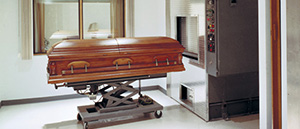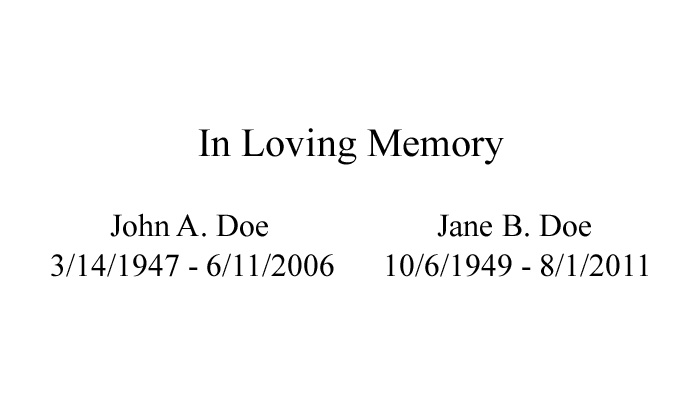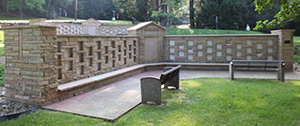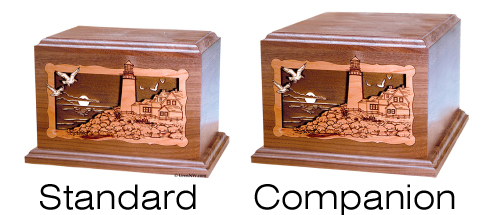Shopping for a companion urn can be a difficult and confusing process. In this guide you will find helpful tips, simple explanations for relevant funeral industry terms, a wide array of options for storing and disposing of a couple's cremated remains, and answers to common questions about companion cremation urns.
1. What is a companion urn?
A companion urn is a cremation container which is intended to hold the remains (i.e., ashes) of two individuals, usually a couple such as a husband and wife.
Companion urns generally hold twice the capacity of of a standard adult urn, which is why they are also sometimes referred to as "double urns", meaning that they are double the size of a standard urn.
Companion urns can be made from the same materials as any standard funeral urn; the only difference is that the companion urn is larger in size and may contain a divider. Please note: Not all urn designs are available in companion size.
An alternate use for a companion urn is to hold the remains of a larger individual. See the next section for sizing information.
2. What size companion urn do we need?
To figure the size needed for a companion urn, take the total pre-cremated body weight of the individuals and convert it to cubic inches.
Thus, for a 200 lb man (roughly 200 cubic inches of remains) and a 140 lb woman (roughly 140 cubic inches of remains), the total capacity you will need in a companion urn is 340 cubic inches.

Some of our companion urns are as small as 350 cubic inches, while others hold 500 cubic inches, but generally the capacity for most of our "double urns" is right around 400 cubic inches. The dimensions and capacity of each cremation urn are listed in the "product details" section on each product page.
3. Should a companion urn be used for a large individual?
We will often recommend using a companion urn when a larger urn is needed, for instance in the case of a large individual.
To be on the safe side, figure that the above calculations basically hold true for the cremated remains of larger people. If a person weighed 350 pounds, then generally you will need a cremation urn with a capacity of at least 350 cubic inches.
 However, to get a bit more technical, body weight isn't the most accurate gauge for measuring needed capacity (although it is the simplest way to calculate).
However, to get a bit more technical, body weight isn't the most accurate gauge for measuring needed capacity (although it is the simplest way to calculate).
Since bone matter is what is left after the normal cremation process, the most accurate calculation for the remaining ashes would be based on the "healthy body weight" based on height.
Therefore, the ash remaining after the cremation of a 400 lb person should be the same as a 100lb person of the same height and bone structure.
But since there are additional factors involved in calculating healthy body weight, such as bone density and structure, as well as a slight amount of variation in cremation processes based on region, training, and technology, we advise either getting a larger urn (such as a companion urn) or develop a plan for dispersing of additional remains through sharing keepsake urns or scattering.
4. Should a couple's ashes be commingled?
Commingling is usually a matter of the personal preference of the couple. If you are a family member in charge of handling the funeral and disposition arrangements, be sure to check the couple's will to see if they had particular instructions regarding the mixing of their ashes.
When an individual's remains come to you from the crematorium, in most cases they will be inside a durable plastic bag which will be placed inside a plastic or cardboard "temporary urn", an inexpensive container provided by the crematory or funeral home. We recommend simply taking the plastic bag out of the temporary urn and placing it inside the permanent urn.
In the case of a companion urn, we recommend placing each of the two individual's plastic bags of ashes into the urn side by side. This is the simplest solution when transferring multiple remains into a double urn.
However, if the couple requested their ashes to be commingled, or if the family decided that commingling was the best expression of the couple's love, then the easiest way to commingle and inurn the ashes is to open one plastic bag and pour the contents of the second into the first. Then you can place the newly mixed ashes into the companion urn for permanent storage.
>>Religious Considerations>>
Some religions specify how cremated remains should be handled. For instance, the commingling of cremated remains is not part of the Roman Catholic tradition for inurnment; a separation inside the container must be maintained. From The Catholic Cemeteries:
![]()
Since the human body was the temple of the Holy Spirit during life, was fed at the Eucharistic table, and will share in the bodily resurrection, contemporary cultural practices like scattering the cremated remains over water or from the air or keeping the cremated remains at home are not considered reverent forms of disposition that the Church requires. Other practices such as commingling cremated remains or dividing up cremated remains among family members or friends are not acceptable for Catholics.
Of course it is best for you to speak with your local priest, or other religious official who will oversee the funeral service.
5. Should there be a divider in the companion urn?
 This feature varies by each individual design. In most ceramic companion urns there are no dividers, while many cultured marble or granite companion urns are constructed with two separate compartments, complete with two separate stoppers for each individual section (our Engraved Photo Companion Urn in Granite, pictured here, has two such compartments).
This feature varies by each individual design. In most ceramic companion urns there are no dividers, while many cultured marble or granite companion urns are constructed with two separate compartments, complete with two separate stoppers for each individual section (our Engraved Photo Companion Urn in Granite, pictured here, has two such compartments).
Metal companion urns may include a divider, and some, as in the case of several of our wood companion urns, the divider is optional, moveable, and removeable.
However, other wood double urns may be made with permanent dividers or separate compartments, so pay careful attention to the product details. Feel free to contact us if you have questions about the specifics of any of our cremation urns.
6. What should the inscription be on a companion urn?
This is one of the most common, and perplexing, questions our customer service team receives concerning companion urns.
As inscriptions are permanently engraved and the standard formats generally include name, date of birth, and date of death, figuring out what to put on an epitaph for two individuals can prove to be a difficult decision.
Here are some helpful tips to help you formulate the perfect memorial.
>>Inscription When Both Are Deceased>>
When both individuals are deceased, the classic epitaph formulations are often the ideal inscription. Here are a few sample formats, which include names and dates of birth and death:


>>Inscription When Both Are Living>>
When you are a couple pre-planning together for your final arrangements and are considering a companion urn, you have the opportunity to discuss how you would like to be memorialized with an inscription.
Generally, pre-planned inscriptions include both names and a sentiment expressing your devotion to one another, such as "Together Forever", "Loving Husband, Devoted Wife", or your wedding date.



>>Inscription When One Is Deceased>>
When one of the companions has passed away, the years married are known and definite, so an option for inscription on the companion urn is to list the number of years the couple was married, or the dates through which they were together.
Another idea which we will often suggest in this situation is to have the urn engraved with an inscription similar one of the ones shown below, then make arrangements for after both individuals are deceased for a simple engraved metal plate to be inscribed with the dates and placed over the top of the original inscription.
This gives the living spouse the ability to have a beautifully engraved memorial urn, then have complete and accurate epitaph information on the urn for posterity.


7. Should we purchase a companion urn in advance?
There are many advantages to selecting and purchasing your companion urn ahead of time, including the ability to pre-plan for your personal preferences while saving your surviving relatives stress when finalizing the funeral.
Although, as noted above, it might take a little bit of arrangement to add a personalized inscription including dates to the pre-purchased urn, the benefits include:
- Peace of mind knowing your resting place has been finalized
- You get the exact urn you want
- You can choose the inscription you want
- You save your loved ones from additional stress
- No need to pay expedited shipping fees
8. How are the remains placed into the companion urn?
When the cremated remains come back to you from the crematorium, in most cases they will be inside plastic or cardboard box known as a "temporary urn", inside of which the remains will be in a durable plastic bag.
We recommend simply taking the plastic bag out of the temporary urn and placing it inside the permanent urn. In the case of a companion urn, most often this is accomplished by placing each of the two individual's plastic bags of ashes into the urn side by side. This is the simplest solution when transferring multiple remains into a double urn.
However, if the couple requested their ashes to be commingled, or if the family decided that commingling was the best expression of the couple's love, then the easiest way to mix the ashes is to open one plastic bag and pour the contents of the second into the first. Then you can place the newly mixed ashes into the companion urn for permanent storage.
In many cases, you can ask the funeral director to take care of this for you. Funeral homes are required by law to use the container of your choice, even if it is purchased from an outside source.
9. What types of companion urns are available?
You can find companion urns in most common urn material types: Wood, Metal, Ceramic, Granite, Marble, and various Biodegradable options. While not all designs may be available, urn manufacturers generally produce a few popular options in companion or double urn size.
 At Urns Northwest, we offer several of our most popular cremation urn designs in companion urn sizes, as well as a few choice urns specifically and uniquely designed for two people.
At Urns Northwest, we offer several of our most popular cremation urn designs in companion urn sizes, as well as a few choice urns specifically and uniquely designed for two people.
For wood urns, our most popular item is the Together Again Companion Urn, a wooden box featuring a 3-dimensional wood carved scene of an old-fashioned country lane with an elderly couple walking arm in arm.
In addition to dozens more wooden companion urns, we also offer double urns in bronze, cultured granite, and a lovely collection of handmade ceramic funeral urns, crafted by a Washington-based ceramic artist, which include the exsquisite traditional Japanese-style fired Raku urns. Browse our collection of companion urns here.
10. Will a companion urn fit into a niche?
 Funeral niches in a mausoleum or columbarium vary in size according to the design. Many funeral homes offer niche space for individuals or couples, or even larger "family" niches. Be sure to find out the dimensions of the niche and compare them with the urn's dimensions, which we list on each product page.
Funeral niches in a mausoleum or columbarium vary in size according to the design. Many funeral homes offer niche space for individuals or couples, or even larger "family" niches. Be sure to find out the dimensions of the niche and compare them with the urn's dimensions, which we list on each product page.
Often a companion urn will be a more economical use of space in a niche as opposed to trying to fit two single standard-sized urns; however, since double urns have larger dimensions, occasionally you will actually need two standard sized urns or an uniquely-shaped companion urn due to niche constraints.
11. Will buying a companion urn save money?
When compared to purchasing two separate urns in a similar style, the answer is a clear "yes".
While companion urns are generally a little more expensive than their standard-sized counterparts, purchasing a single companion urn will save money in comparison to the cost of buying two standard sized urns.
12. Can other items be placed into a companion urn?
Yes. You can easily make room for small and/or flat items such as photographs, letters, notes, or small jewelry items.
Including meaningful keepsakes in the companion urn is a beautiful way to personalize the urn in memory of the couple.
If you are planning on burying the urn at a cemetery or storing the urn in a columbarium niche, be sure to see if the facilities have any restrictions on inclusions with the remains.
Shop our complete collection of companion urns here.

